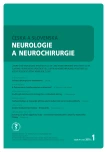Dynamic Methods of Quantitative Sensory Testing
Authors:
S. Kincová 1,2; E. Vlčková 1,2; I. Šrotová 1,2; J. Raputová 1; J. Bednařík 1,2
Authors‘ workplace:
Neurologická klinika LF MU a FN Brno
1; CEITEC – Středoevropský technologický institut, MU, Brno
2
Published in:
Cesk Slov Neurol N 2016; 79/112(1): 68-76
Category:
Original Paper
Overview
Background:
So called “dynamic quantitative sensory methods” (dQST) represent relatively new QST application which enables to objectify certain mechanisms of pain processing, e.g. central integration or descending control. Their dysfunction may contribute to the development of chronic painful conditions. dQST methods proved the potential to predict the development of chronic postoperative pain. Conditioned pain modulation (CPM) and temporal summation (TS) are the most commonly used dQST tests.
Patients and methods:
The CPM and TS testing was performed in a group of 77 healthy volunteers (47 women tested in the ovulatory phase of the menstrual cycle, 30 men, age range 19–73) using thermal pain stimuli. Efficiency of CPM and TS mechanism including age and gender influence was evaluated.
Results:
Efficient CPM was found in 84% of healthy volunteers. In remaining 16%, the inefficiency was mainly due to low intensity of testing or modulatory stimuli. Based on the temperature used, efficient TS mechanism was found in 92% or 98% of healthy individuals. Women in the ovulatory phase of the menstrual cycle showed significantly more efficient CPM comparing to men. No sex differences of TS testing were found. Age had no significant effect on the CPM or TS mechanism in our group of healthy voluteers.
Conclusions:
Our study has verified the applicability of CPM and TS algorithms used. Women in ovulatory phase of the menstrual cycle show increased anti-nociceptive setting comparing to men. No significant effect of age on central modulation of pain perception has been found in pain-free healthy individuals.
Key words:
pain perception – nociceptive pain – neuropathic pain – temporal summation – conditioned pain modulation – pain measurement – sex factors – age factors
The authors declare they have no potential conflicts of interest concerning drugs, products, or services used in the study.
The Editorial Board declares that the manuscript met the ICMJE “uniform requirements” for biomedical papers.
Sources
1. Vlčková E, Šrotová I. Vyšetření senzitivity. Cesk Slov Neurol N 2014; 77/ 110 : 402 – 418.
2. Cruccu G, Sommer C, Anand P, Attal N, Baron R, Garcia-Larrea L et al. EFNS guidelines on neuropathic pain assess-ment: revised 2009. Eur J Neurol 2010; 17(8): 1010 – 1018. doi: 10.1111/ j.1468-1331.2010.02969.x.
3. Rolke R, Baron R, Maier C, Tölle TR, Treede RD, Beyer A et al. Quantitative sensory testing in the German Research Network on Neuropathic Pain (DFNS): standardized protocol and reference values. Pain 2006; 123(3): 231 – 243.
4. Yarnitsky D, Crispel Y, Eisenberg E, Granovsky Y, Ben-Nun A, Sprecher E et al. Prediction of chronic post-operative pain: pre-operative DNIC testing identifies patients at risk. Pain 2008; 138(1): 22 – 28.
5. Yarnitsky D. Conditioned pain modulation (the diffuse noxious inhibitory control-like effect): its relevance for acute and chronic pain states. Curr Opin Anaesthesiol 2010; 23(5): 611 – 615. doi: 10.1097/ ACO.0b013e32833c348b.
6. Arendt-Nielsen L, Yarnitsky D. Experimental and clinical applications of quantitative sensory testing applied to skin, muscles and viscera. J Pain 2009; 10(6): 556 – 572. doi: 10.1016/ j.jpain.2009.02.002.
7. Eisenberg E, Midbari A, Haddad M, Pud D. Predicting the analgesic effect to oxycodone by ‚static‘ and ‚dynamic‘ quantitative sensory testing in healthy subjects. Pain 2010; 151(1): 104 – 109. doi: 10.1016/ j.pain.2010.06.025.
8. Yarnitsky D. Conditioned pain modulation (the diffuse noxious inhibitory control-like effect): its relevance for acute and chronic pain states. Curr Opin Anaesthesiol 2010; 23(5): 611 – 615. doi: 10.1097/ ACO.0b013e32833c348b.
9. Tousignant-Laflamme Y, Marchand S. Excitatory and inhibitory pain mechanisms during the menstrual cycle in healthy women. Pain 2009; 146(1 – 2): 47 – 55. doi: 10.1016/ j.pain.2009.06.018.
10. Granot M, Weissman-Fogel I, Crispel Y, Pud D, Granovsky Y, Sprecher E et al. Determinants of endogenous analgesia magnitude in a diffuse noxious inhibitory control (DNIC) paradigm: do conditioning stimulus painfulness, gender and personality variables matter? Pain 2008; 136(1 – 2): 142 – 149.
11. Yarnitsky D, Bouhassira D, Drewes AM, Fillingim RB, Granot M, Hansson P et al. Recommendations on practice of conditioned pain modulation (CPM) testing. Eur J Pain 2015; 19(6): 805 – 806. doi: 10.1002/ ejp.605.
12. Rezaii T, Hirschberg AL, Carlström K, Ernberg M. The influence of menstrual phases on pain modulation in healthy women. J Pain 2012; 13(7): 646 – 655. doi: 10.1016/ j.jpain.2012.04.002.
13. Šrotová I, Vlčková E, Straková J, Kincová S, Adamová B, Dušek L et al. Validace české verze komplexního protokolu kvantitativního testování senzitivity. Cesk Slov Neurol N 2015; 78/ 111(4): 442 – 452.
14. Popescu A, LeResche L, Truelove E, Drangsholt M. Gender differences in pain modulation by diffuse noxious inhibitory controls: a systematic review. Pain 2010; 150(2): 309 – 318. doi: 10.1016/ j.pain.2010.05.013.
15. Van Wijk G, Veldhuijzen D. Perspective on diffuse noxious inhibitory controls as a model of endogenous pain modulation in clinical pain syndromes. Pain 2010; 11(5): 408 – 419. doi: 10.1016/ j.jpain.2009.10.009.
16. Edwards R, Fillingim R, Ness T. Age-related differences in endogenous pain modulation: a comparison of diffuse noxious inhibitory controls in healthy older and younger adults. Pain 2003; 101(1 – 2): 155 – 165.
17. Edwards RR, Ness TJ, Weigent DA, Fillingim RB. Individual differences in diffuse noxious inhibitory controls (DNIC): association with clinical variables. Pain 2003; 106(3): 427 – 437.
18. Ware JE jr, Sherbourne CD. The MOS 36-item short-form health survey (SF-36). I. Conceptual framework and item selection. Med Care 1992; 30(6): 473 – 483.
Labels
Paediatric neurology Neurosurgery NeurologyArticle was published in
Czech and Slovak Neurology and Neurosurgery

2016 Issue 1
Most read in this issue
- Sympathetic Skin Response in the Diagnosis of Small Fibre Neuropaty
- Investigation of the Retinal Nerve Fiber Layer in Multiple Sclerosis Using Spectral Domain Optical Coherence Tomography
- Complications of Cranioplasty after Decompressive Craniectomy
- Indications for Decompressive Craniectomy
